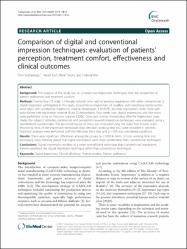| dc.contributor.author | Yüzbaşıoğlu, Emir | |
| dc.contributor.author | Kurt, Hanefi | |
| dc.contributor.author | Turunç, Rana | |
| dc.contributor.author | Bilir, Halenur | |
| dc.date.accessioned | 10.07.201910:49:13 | |
| dc.date.accessioned | 2019-07-10T19:36:22Z | |
| dc.date.available | 10.07.201910:49:14 | |
| dc.date.available | 2019-07-10T19:36:22Z | |
| dc.date.issued | 2014 | en_US |
| dc.identifier.citation | Yüzbaşıoğlu, E., Kurt, H., Turunç, R. ve Bilir, H. (2014). Comparison of digital and conventional impression techniques: Evaluation of patients' perception, treatment comfort, effectiveness and clinical outcomes. BMC Oral Health, 14(1). https://dx.doi.org/10.1186/1472-6831-14-10 | en_US |
| dc.identifier.issn | 1472-6831 | |
| dc.identifier.uri | https://hdl.handle.net/20.500.12511/1141 | |
| dc.identifier.uri | https://dx.doi.org/10.1186/1472-6831-14-10 | |
| dc.description.abstract | Background: The purpose of this study was to compare two impression techniques from the perspective of patient preferences and treatment comfort.Methods: Twenty-four (12 male, 12 female) subjects who had no previous experience with either conventional or digital impression participated in this study. Conventional impressions of maxillary and mandibular dental arches were taken with a polyether impression material (Impregum, 3 M ESPE), and bite registrations were made with polysiloxane bite registration material (Futar D, Kettenbach). Two weeks later, digital impressions and bite scans were performed using an intra-oral scanner (CEREC Omnicam, Sirona). Immediately after the impressions were made, the subjects' attitudes, preferences and perceptions towards impression techniques were evaluated using a standardized questionnaire. The perceived source of stress was evaluated using the State-Trait Anxiety Scale. Processing steps of the impression techniques (tray selection, working time etc.) were recorded in seconds. Statistical analyses were performed with the Wilcoxon Rank test, and p < 0.05 was considered significant.Results: There were significant differences among the groups (p < 0.05) in terms of total working time and processing steps. Patients stated that digital impressions were more comfortable than conventional techniques.Conclusions: Digital impressions resulted in a more time-efficient technique than conventional impressions. Patients preferred the digital impression technique rather than conventional techniques. | en_US |
| dc.language.iso | eng | en_US |
| dc.publisher | BioMed Central | en_US |
| dc.rights | info:eu-repo/semantics/openAccess | en_US |
| dc.rights | Attribution 2.0 Generic | * |
| dc.rights.uri | https://creativecommons.org/licenses/by/2.0/ | * |
| dc.subject | Clinical Efficiency | en_US |
| dc.subject | Digital Impression | en_US |
| dc.subject | Patient Comfort | en_US |
| dc.subject | Patient Preference | en_US |
| dc.title | Comparison of digital and conventional impression techniques: Evaluation of patients' perception, treatment comfort, effectiveness and clinical outcomes | en_US |
| dc.type | article | en_US |
| dc.relation.ispartof | BMC Oral Health | en_US |
| dc.department | İstanbul Medipol Üniversitesi, Diş Hekimliği Fakültesi, Protetik Diş Tedavisi Ana Bilim Dalı | en_US |
| dc.authorid | 0000-0001-5348-6954 | en_US |
| dc.authorid | 0000-0001-7385-8321 | en_US |
| dc.authorid | 0000-0002-4983-8563 | en_US |
| dc.identifier.volume | 14 | en_US |
| dc.identifier.issue | 1 | en_US |
| dc.relation.publicationcategory | Makale - Uluslararası Hakemli Dergi - Kurum Öğretim Elemanı | en_US |
| dc.identifier.doi | 10.1186/1472-6831-14-10 | en_US |
| dc.identifier.wosquality | Q2 | en_US |
| dc.identifier.scopusquality | Q2 | en_US |



















